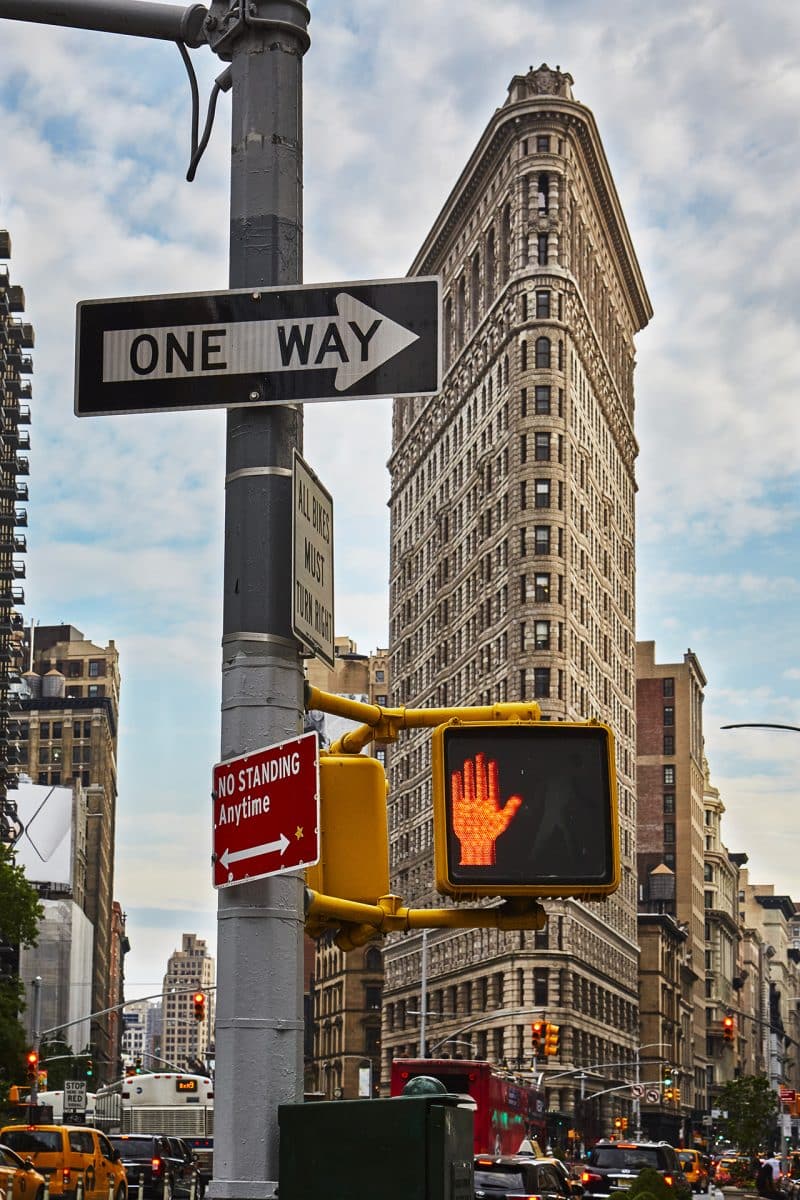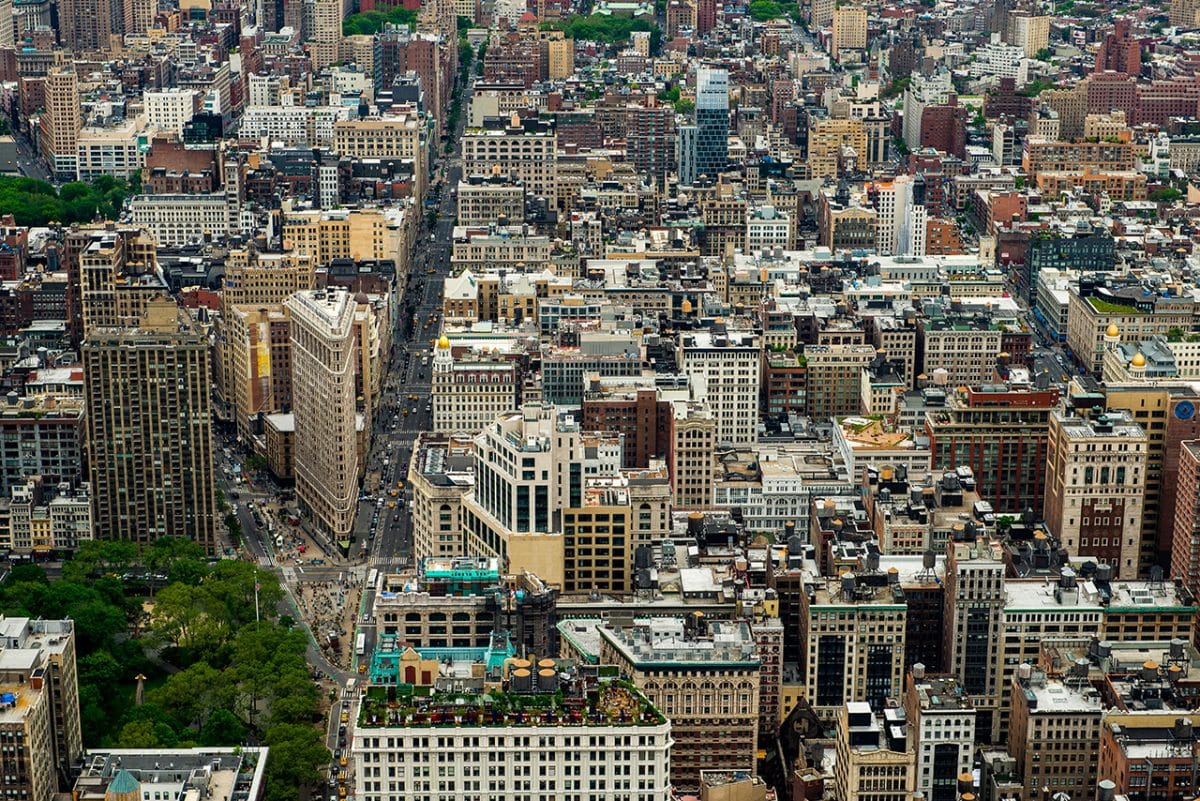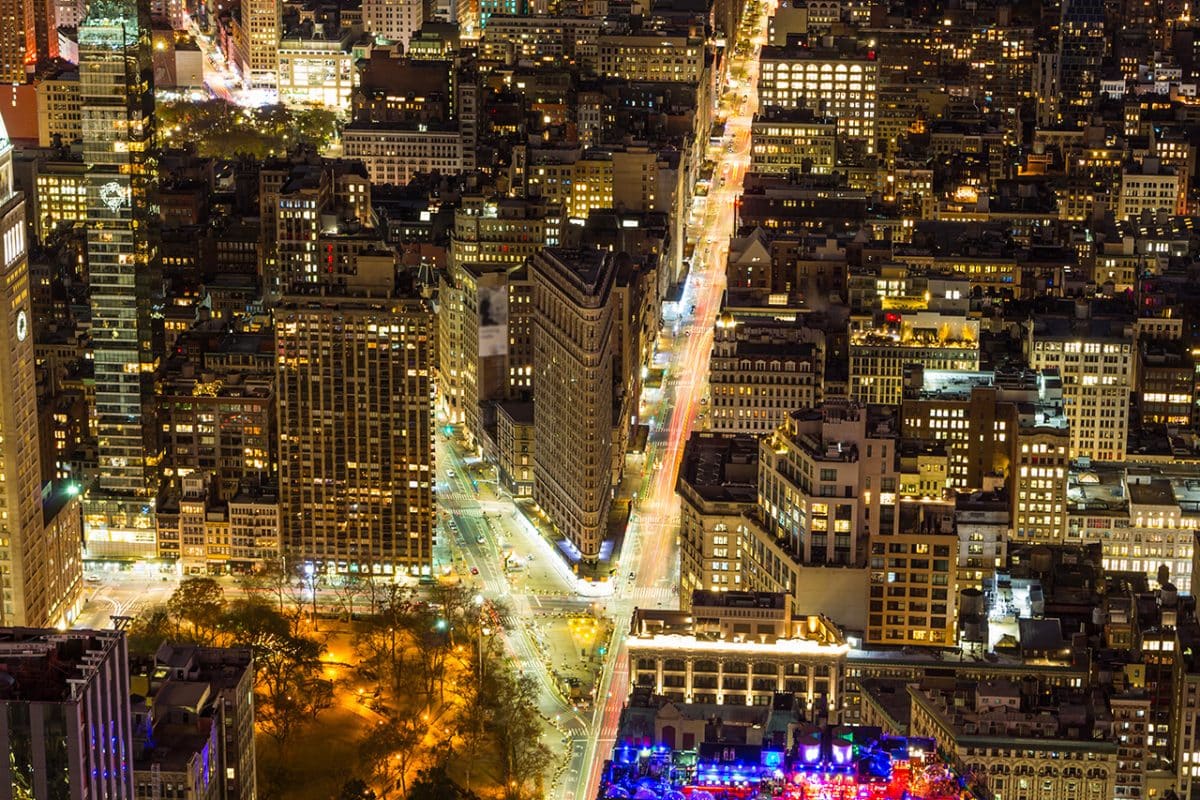In the heart of Manhattan stands a triangular silhouette that has left an indelible mark on the New York skyline: the Flatiron Building. This architectural marvel, instantly recognisable, attracts hundreds of visitors every day to immortalise its unique shape. While most tourists are content to photograph it, few really know its fascinating history and the treasures that surround it. Since 2021, this iconic monument has been undergoing major renovations, which continue to this day. Despite this work, the Flatiron remains a must-see on any trip to New York, as much for its historical value as for the dynamic atmosphere of the district to which it gave its name.
A little history
The Flatiron Building, originally called the Fuller Building, represents a major chapter in American architectural history. Built in a record 24 months between 1900 and 1902, it was one of New York’s first skyscrapers. At that pioneering time, its 22 storeys and 87 metres in height made it one of the city’s most imposing buildings – a far cry from modern giants such as One World Trade Center, which stands at 417 metres today.
It was visionary businessman George A. Fuller who commissioned the construction of this building to house his company’s offices. The building soon attracted prestigious tenants, including the famous New York Times newspaper, which moved in shortly after its inauguration. This journalistic presence inspired the creators of the Spider-Man comics to set up the fictional offices of the Daily Bugle, where Peter Parker works.
The Flatiron’s influence on its surroundings was so profound that it eventually gave its name to the entire district: the Flatiron District. In the ultimate recognition of its importance, the building was designated a National Historic Site in 1989, formalising its status as an American architectural treasure.
Remarkable architecture
A distinctive shape
The most striking feature of the Flatiron is undoubtedly its triangular shape, which has earned it its popular nickname. “Flat iron” is a perfect analogy for the building’s slender silhouette. Some also see it as the shape of a ship’s prow cutting through Manhattan’s urban waves.
This architectural daring is the work of Daniel Burnham, an American architect whose vision was initially greeted with scepticism. Many critics predicted that the triangular structure would not withstand the powerful winds that sweep through New York’s avenues. More than a century later, its sturdy steel frame still proves the foresight of its designer.
With a total surface area of 11,000 m², the building represented a considerable technical feat for its time. An often overlooked aspect of the Flatiron is the harmonious integration of its facades with the surrounding urban fabric. So much so that when approached from the side, the building almost blends into the landscape – it’s only when you face it that its singular geometry is fully revealed.
A little-known precursor
While the Flatiron is world-famous, few people realise that it is not the only triangular building in New York. In the financial district, at 1 Wall Street Court, stands another building with a similar shape, but which has never achieved the fame of its illustrious cousin. This is a reminder that, in addition to its unique architecture, the Flatiron also owes its fame to its strategic location at the crossroads of major thoroughfares.

The Flatiron today
Today, the Flatiron Building houses mainly corporate offices. This commercial vocation unfortunately limits the possibilities for tourists to visit the building. Although access to the upper floors is forbidden to the public, the entrance hall remains accessible and offers an interesting historical presentation of the building’s evolution.
Despite this restriction, the Flatiron retains a special place in the collective imagination, fuelled by its many appearances in popular culture. Its most famous role is as the headquarters of the Daily Bugle in the film adaptations of Spider-Man, ensuring its recognition by new generations.
The Flatiron’s silhouette stands out all the more in Manhattan’ s vertical landscape, contrasting sharply with contemporary skyscrapers. While towers such as the One World Trade Center push the limits of what is possible ever higher, the Flatiron bears witness to a more measured but no less audacious era in New York architecture.
How to photograph the Flatiron
For photography enthusiasts, the Flatiron is a prime subject, but you still need to know where to position yourself to capture its majesty. Here are a few ideal locations from which to capture this monument at its best.
The first recommended vantage point is at the entrance to Madison Square Park. This position offers a slightly offset perspective that perfectly highlights the triangular shape of the building. For an even more interesting composition, the small square in front of the building, with its chairs and tables, can be used to vary the foreground.
Another iconic shot uses the clock on 5th Avenue, in front of Eataly, as a foreground element. This framing creates a dynamic composition between the circular element of the clock and the angular lines of the Flatiron in the background.
For those in the know, the exact location of the Flatiron is at the intersection of Broadway (Manhattan’s only non-rectilinear street), 5th Avenue and 23rd Street. This confluence of major arteries explains the triangular shape of the site and, consequently, that of the building.

Explore the Flatiron District
Madison Square Park: an urban oasis
Just a stone’s throw from the Flatiron Building lies Madison Square Park, a green lung in the heart of the district. Not only does this park offer magnificent views of the famous building, it also makes a refreshing stop-off on a day of urban exploration.
The park is more than just a green space: it regularly hosts cultural events, outdoor art exhibitions and concerts. To find out what’s on during your stay, take a look at the park’s official website.
Must-see cultural attractions
The Flatiron District is packed with attractions to suit all tastes. Fans of TV series won’t want to miss The Friends Experience, a complete immersion in the world of the cult sitcom. Fans of all ages will be delighted by the reconstructed sets and the many souvenirs.
For apprentice wizards, the gigantic Harry Potter shop is a must. With its three floors covering 1,850 m² and its 15 themed rooms, this temple to magic is the largest of its kind ever designed for Muggles. Collector’s items and themed souvenirs abound.
Fans of photographic art will want to head for the Fotografiska museum, housed in a magnificent 19th-century building on Park Avenue. As well as regularly changing exhibitions, this cultural venue offers a varied programme of musical events, dance performances, yoga sessions and film screenings. The restaurant and lounge bars complete the cultural experience.
Original shopping
For an authentic souvenir of your stay in New York, a visit to Fishs Eddy is a must. This unique boutique, a veritable Ali Baba’s cave, offers an impressive collection of crockery and decorative objects in the colours of New York. From bowls and mugs to tea towels and glasses, each piece tells a different story about the city.

Gastronomic experiences in the area
Iconic restaurants
After a day of exploring, the Flatiron district offers plenty of options to satisfy even the most demanding appetites. Burger & Lobster is a great value for money place to enjoy lobster in all its forms, at far more affordable prices than many New York establishments.
Fans of tasty burgers can’t leave the neighbourhood without trying those from Shake Shack, a local institution. The original location of this now international chain is in Madison Square Park, offering the chance to enjoy these delicacies on the terrace overlooking the Flatiron Building.
Panoramic views and cocktails
To round off the day in style, the 230 Fifth Rooftop offers a splendid view of theEmpire State Building. Although popular with tourists, this rooftop fully deserves its popularity. Whether it’s for an evening drink or a weekend brunch, the atmosphere is festive and the views spectacular. In winter, heated igloos allow you to enjoy the view even in the coldest weather.
Practical guide for visitors
To help you plan your visit to the Flatiron and its surrounding area, here is some practical information. The exact address of the Flatiron Building is 175 5th Avenue, at the intersection of 5th Avenue, Broadway and 23rd Street.
The district is easily accessible by metro via several lines: the N, R and W lines at 23rd Street station, or the 4, 6 and 6 Express lines at 23rd Street station on Park Avenue South.
Even if your stay in New York is short, a visit to the Flatiron is a must. It only takes a few minutes to visit the outside of the building, but the attractions of the area are worth at least half a day’s exploration. To get the most out of the experience, plan your visit for the morning, so that you have the best possible light for your photographs.
Good to know
Can I visit the Flatiron Building?
Opportunities to visit the Flatiron Building are limited. While you can admire the exterior of the building and take photographs at your leisure, access to the interior is restricted. The entrance hall is still open to the public and contains some historical information, but the upper floors, occupied by corporate offices, are closed to visitors.
Why is the Flatiron Building called that?
The name “Flatiron” is a direct reference to the triangular shape of the building, which is reminiscent of an antique iron. Although its official name was originally Fuller Building, in honour of its sponsor, it was the popular nickname that took hold over time, to the point of becoming its official designation.


